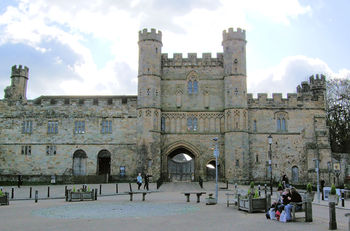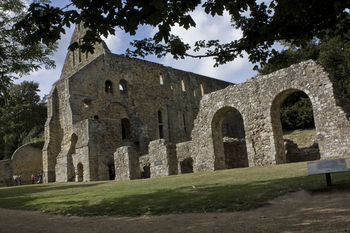Battle Abbey: Difference between revisions
imported>Richard Nevell (Created page with "{{subpages}} {{Image|Battle Abbey gatehouse, 2008.jpg|right|350px|The 14th-century gatehouse at Battle Abbey}} '''Battle Abbey''' was founded as a [[Benedictine monk|Benedictin...") |
imported>Richard Nevell No edit summary |
||
| Line 1: | Line 1: | ||
{{subpages}} | {{subpages}} | ||
{{Image|Battle Abbey gatehouse, 2008.jpg|right|350px| | {{Image|Battle Abbey gatehouse, 2008.jpg|right|350px|Battle Abbey's 14th-century gatehouse}} | ||
{{Image|Battle Abbey east range, 2009.jpg|right|350px|The east range of Battle Abbey}} | |||
'''Battle Abbey''' was founded as a [[Benedictine monk|Benedictine monastery]] by [[William the Conqueror]] in the late 11th century on the spot where King Harold was killed during the [[Battle of Hastings]]. With [[Dissolution of the Monasteries]] in the 16th century under [[Henry VIII]] Battle Abbey was taken under secular control and many of its buildings demolished.<ref>Coad, Jonathan (2007). ''Battle Abbey and Battlefield''. London: English Heritage. p. 3. ISBN 978-1-905624-20-1.</ref> | '''Battle Abbey''' was founded as a [[Benedictine monk|Benedictine monastery]] by [[William the Conqueror]] in the late 11th century on the spot where King Harold was killed during the [[Battle of Hastings]]. With [[Dissolution of the Monasteries]] in the 16th century under [[Henry VIII]] Battle Abbey was taken under secular control and many of its buildings [[demolitions|demolished]].<ref>Coad, Jonathan (2007). ''Battle Abbey and Battlefield''. London: English Heritage. p. 3. ISBN 978-1-905624-20-1.</ref> | ||
William the | William the Conqueror most likely founded Battle Abbey as part of the penitence imposed on him by [[Pope Alexander II]] for waging war on the English.<ref>Coad, ''Battle Abbey and Battlefield'', p. 32.</ref><ref>Bachrach, David S. (2003). ''Religion and the Conduct of War: c.300 – c. 1215''. Woodbridge: Boydell Press. p. 77. ISBN 0-85115-944-3.</ref> | ||
==Dissolution and Private Ownership== | |||
The Dissolution of the monasteries was conducted in the late 1530 under King Henry VIII. As part of this, on 27 May 1538 Battle Abbey was given over to the control of Dr Richard Layton, an official of the Crown. The monastic community consisted of an [[abbot]], John Hammond who was given a pension of £100, and 16 monks. In August that year and much of its associated land was given by Henry to Sir Anthony Browne. Under his ownership much of the abbey complex was pulled down, including the church, chapter house, and refectory. An inventory of the abbey's contents was conducted by Layton when it was taken over by the Crown, and he remarked "so beggary a house I never see, nor so filthy stuff". Three years earlier the Abbey had an income of £880, making it one of the richest Benedictine houses in England. Layton's testimony likely means the monks had been removing valuables from the Abbey in anticipation of its seizure by the king.<ref>Coad, ''Battle Abbey and Battlefield'', pp. 41–42.</ref> | |||
==References== | |||
{{reflist}} | {{reflist}} | ||
Revision as of 14:09, 7 November 2012
Battle Abbey was founded as a Benedictine monastery by William the Conqueror in the late 11th century on the spot where King Harold was killed during the Battle of Hastings. With Dissolution of the Monasteries in the 16th century under Henry VIII Battle Abbey was taken under secular control and many of its buildings demolished.[1]
William the Conqueror most likely founded Battle Abbey as part of the penitence imposed on him by Pope Alexander II for waging war on the English.[2][3]
Dissolution and Private Ownership
The Dissolution of the monasteries was conducted in the late 1530 under King Henry VIII. As part of this, on 27 May 1538 Battle Abbey was given over to the control of Dr Richard Layton, an official of the Crown. The monastic community consisted of an abbot, John Hammond who was given a pension of £100, and 16 monks. In August that year and much of its associated land was given by Henry to Sir Anthony Browne. Under his ownership much of the abbey complex was pulled down, including the church, chapter house, and refectory. An inventory of the abbey's contents was conducted by Layton when it was taken over by the Crown, and he remarked "so beggary a house I never see, nor so filthy stuff". Three years earlier the Abbey had an income of £880, making it one of the richest Benedictine houses in England. Layton's testimony likely means the monks had been removing valuables from the Abbey in anticipation of its seizure by the king.[4]
References
- ↑ Coad, Jonathan (2007). Battle Abbey and Battlefield. London: English Heritage. p. 3. ISBN 978-1-905624-20-1.
- ↑ Coad, Battle Abbey and Battlefield, p. 32.
- ↑ Bachrach, David S. (2003). Religion and the Conduct of War: c.300 – c. 1215. Woodbridge: Boydell Press. p. 77. ISBN 0-85115-944-3.
- ↑ Coad, Battle Abbey and Battlefield, pp. 41–42.

